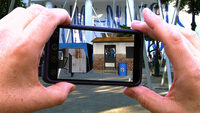 There will always be a place for PowerPoint presentations, especially if business boardrooms have anything to say about it. But as an effective learning tool, there is room for improvement.
There will always be a place for PowerPoint presentations, especially if business boardrooms have anything to say about it. But as an effective learning tool, there is room for improvement.
Even the most attentive student isn’t going to absorb everything they need from bullet points and anecdotes. Yet in many training scenarios, this is the only realistic option. On-site training can be either too dangerous or simply ineffective, as genuine hazards cannot be replicated in a convincing or safe manner.
Until now, that is. The advent of convincing and accessible virtual reality (VR) and augmented reality (AR) platforms allows for training to take place that is more practical, realistic and engaging than existing training solutions. The ability to replicate real locations and introduce convincing, danger-free hazards could herald a revolution in health and safety training, reducing deaths and injuries in high-risk professions.
Constructing worlds
One of the industries where health and safety training is most paramount is construction. 2016 statistics for the UK show that 18% of workplace deaths occurred in this industry, with construction machinery being a particular danger. Even on-site training lacks a real threat to drive home the dangers, and can miss out on the correlation between other environmental factors, such as how noise impacts the awareness of others.
Virtual reality can attend to all of these factors. Constructing a virtual representation of a building site allows users to interact with it in a realistic manner. Tasks such as operating equipment or picking up and depositing resources can be simulated, with hazards providing a ‘fail state’. A construction vehicle which does not see you may cross your path, ‘killing’ your virtual avatar and restarting the test.
This visceral experience shows the immediate consequences of your actions, and can better teach participants to be aware of the environment around them. When applied to a site model that has not yet been constructed in real life, it can also influence the planning stage. Preemptive testing of a site layout can influence design decisions, helping to optimise the working environment and reduce risks ahead of time.
This replication of real-world environments has broad uses across a variety of sectors. The MRO industry has already begun exploring the potential of VR, with CAD software like Autodesk offering tools to convert models to VR. This allows a model of a building to be rotated and zoomed in on in front of you, pulling data from multiple sources. This could potentially include live usage information, such as energy expenditure and room occupancy.
Augmenting the workplace
Perhaps more exciting are the applications of augmented reality, or AR. Instead of constructing a fully virtual world, AR allows data to be overlaid on the real world. In practice, this is much like the ‘heads up display’ used in films like The Terminator, or in most popular video games. Using either a phone camera or a device like Google Glass or Microsoft’s Hololens, virtual objects are superimposed on the real environment.
This could be an information bubble on a landmark as you look at it, for example, or directions being painted on the path in front of you. Indeed, the introduction of the latest iPhone and Android models has increased the buzz around VR to fever pitch. The respective ARKit and ARCore frameworks now let developers harness the two or three camera setups on phones to create AR apps. Early examples include Ikea’s app, which allows you to preview virtual versions of the company’s furniture in your home.
It’s still early days when it comes to the applications of AR in workplace safety, but the possibilities are intriguing. With VR proving relatively expensive and immobile, due to its reliance on desktop computers, AR could be a more practical solution for training. Glasses style AR hardware could add digital hazards to a real training environment, or even augment physical props, making a plain cardboard box look like a box of tools.
Feeding a CAD model of a building into this hardware could even allow technicians to view the position of wires or pipes through a wall as they look at it, improving maintenance safety. Other data such as maintenance logs, hazard warnings, or even directions to a desired location could also be overlaid on the world. This could have other applications: for example, guiding external contractors or even ambulance personnel to a specific location on site.
The cost and mobility of hardware, as well as the intricacies of developing these virtual environments, remain something of a barrier to widescale adoption. But the fact that the technology has become viable in just a few short years hints at the potential, as does the quick uptake across industry segments. Both VR and AR offer significant opportunities to engage employees in safety training, as well as providing more detailed information on-site.
This post was contributed by SAMS Ltd, a health and safety consultancy & training company based in Ramsgate, Kent. SAMS offers a variety of health and safety courses online, as well as classroom courses, business advisory services and event management.